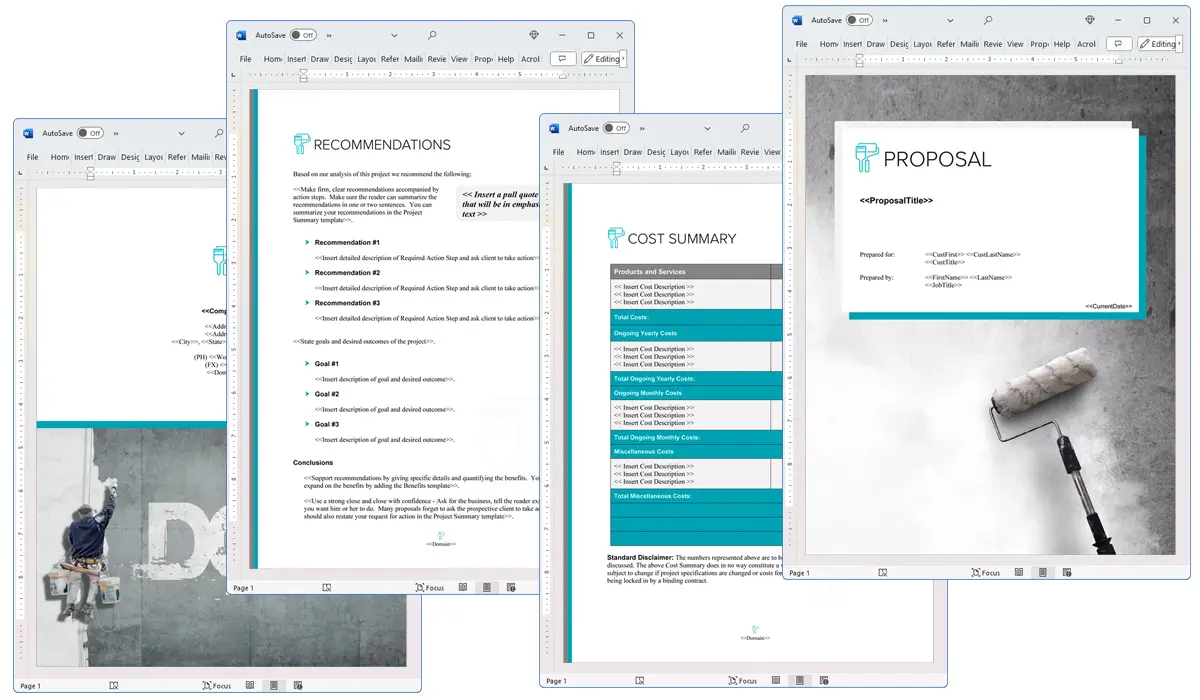What is the Culture chapter used for?
Proposal Kit Professional Bundle adds more design themes, all six Contract Packs,
a project management library, and Expert Edition software.

Illustration of Proposal Pack Painter #4
We include this Culture chapter template in every Proposal Pack, along with thousands more. You assemble this chapter with others in various combinations to create custom-tailored business proposals, plans, reports, and other documents. Proposal Packs apply custom visual designs to the templates, giving the final documents a consistent professional finish.
 DOWNLOADABLE, ONE-TIME COST, NO SUBSCRIPTION FEES
DOWNLOADABLE, ONE-TIME COST, NO SUBSCRIPTION FEES
Overview of the Culture Chapter
The Culture chapter in a proposal document plays an important role in showcasing the organizational or group culture to potential partners, clients, or stakeholders. This chapter serves as a window into the values, behaviors, and social norms that define an organization. It helps in painting a vivid picture of the working environment and the ethos that team members bring to their daily tasks and long-term objectives.
How is the Culture Chapter Used?
In business proposals, the Culture chapter is used to align an organization's cultural attributes with the values or expectations of the client or partner. This alignment can be critical in securing projects, partnerships, or funding, especially when the organizational culture strongly influences decision-making processes. It assures the potential partners that their expectations will be met in a manner that resonates with their own company culture.
What is Included in the Culture Chapter?
Typically, the Culture chapter includes:
- A description of the organization's core values and mission statement.
- Insights into the daily work environment and how team members interact.
- Examples of traditions or rituals that exemplify the organization's culture.
- Testimonials or quotes from employees about the culture.
- Any cultural awards or recognitions that the organization has received.
This combination of elements provides a comprehensive view of the organization's internal atmosphere and social dynamics.
Use Case Examples for the Culture Chapter
The Culture chapter can be tailored and included in various types of proposals such as:
- Advertising: To convey how the creative ethos of the agency aligns with the innovative spirit of the client.
- Marketing: Demonstrating a marketing firm's collaborative and client-focused culture to reassure clients of personalized and attentive service.
- Sponsorship: Showcasing a sports team's community-oriented culture to attract sponsors interested in grassroots engagement.
- Fashion: Illustrating a brand's commitment to sustainability and ethical practices to align with like-minded partners or projects.
- Image: Reflecting a company's professional and polished culture in proposals for corporate partnerships.
- Art: Conveying an artistic group's unique and inclusive culture to potential exhibitors or collaborators.
- Creative: Highlighting a design studio's dynamic and innovative culture to win creative project contracts.
Key Takeaways
- The Culture chapter is important for highlighting the unique cultural aspects of an organization.
- This chapter helps align the organization's culture with potential clients or partners' expectations.
- It includes detailed descriptions of values, work environment, employee testimonials, and recognitions.
- The Culture chapter is and can be adapted for various industries including advertising, marketing, sponsorship, fashion, and more.
- Effectively presented, this chapter can significantly impact the success of a business proposal by establishing cultural compatibility.

Illustration of Proposal Pack Mining #4
 What Our Clients Say
What Our Clients SayProposal Pack has great examples and will help you develop professional proposals. No need to start from scratch, this tool leverages tried and true formats and content to help you develop proposals that help you make the short list."
Manager, Engineering
 4.7 stars, based on 845 reviews
4.7 stars, based on 845 reviewsRelated Chapters
- Mediation
- Curation
- Immigration
- Behavior
- Adoption
- Heritage
- Stereotypes
- Discrimination
- Wardrobe
- Decorations
- Unification
- Community
- Traditions
- Historical Value
- Legacy
- Work-Life Balance
- Myths
- Symbology
- Decor
- Themes
- Seasonal
- Special Occasions
- Religion
- Parenting
- Social Networking
- Menu
- Constituency
- Relationships
- Beliefs
- Trust
- Isolation
- Etiquette
- Dress Code
- Holidays
- Arts
- Harassment
- Artifacts
- Ideology
- Culture Change
- Historical Significance
- Equity and Inclusion
Samples Using the Culture Chapter
Document Layouts Using the Culture Chapter
- Racial Diversity Training and Awareness Proposal
- Charter School Educational Proposal
- Indigenous Community Funding Project Proposal
- Fighting Discrimination Funding Proposal
- Preservation of a Native Culture and Language Proposal
- Readiness Assessment Project Proposal
- Awareness and Sensitivity Training in the Workplace Proposal
- Employing a Culturally Diverse Workforce Proposal
- New Office Location Business Plan
- Healthcare Workshop and Conference Proposal
- Arts and Cultural Heritage Funding Project Proposal

The Culture chapter and other chapters are integrated into a Word document as illustrated here in the Proposal Pack Classic #18 design theme. There are hundreds of design themes available, and every design theme includes the Culture chapter template.
A proper business proposal will include multiple chapters. This chapter is just one of many you can build into your proposal. We include the complete fill-in-the-blank template in our Proposal Pack template collections. We also include a library of sample proposals illustrating how companies in different industries, both large and small, have written proposals using our Proposal Packs. This template will show you how to write the Culture.
We include a chapter library for you to build from based on your needs. All proposals are different and have different needs and goals. Pick the chapters from our collection and organize them as needed for your proposal.
Using the Proposal Pack template library, you can create any business proposal, report, study, plan, or document.
 Ian Lauder has been helping businesses write their proposals and contracts for two decades. Ian is the owner and founder of Proposal Kit, one of the original sources of business proposal and contract software products started in 1997.
Ian Lauder has been helping businesses write their proposals and contracts for two decades. Ian is the owner and founder of Proposal Kit, one of the original sources of business proposal and contract software products started in 1997.By Ian Lauder
 Published by Proposal Kit, Inc.
Published by Proposal Kit, Inc.


 Cart
Cart
 Facebook
Facebook YouTube
YouTube X
X Search Site
Search Site